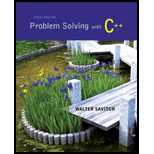
Concept explainers
Write a
86 cents can be given as
3 quarter(s) 1 dime(s) and 1 penny(pennies)
Use coin denominations of 25 cents (quarters), 10 cents (dimes), and 1 cent (pennies). Do not use nickel and half-dollar coins. Your program will use the following function (among others):
void computeCoins(int coinValue, int& num, int& amountLeft);
//Precondition: 0 < coinValue < 100; 0 <= amountLeft < 100.
//Postcondition: num has been set equal to the maximum number
//of coins of denomination coinValue cents that can be obtained
//from amountLeft. Additionally, amountLeft has been decreased
//by the value of the coins, that is, decreased by
//num * coinValue.
For example, suppose the value of the variable amountLeft is 86. Then, after the following call, the value of number will be 3 and the value of amountLeft will be 11 (because if you take 3 quarters from 86 cents, that leaves 11 cents):
computeCoins(25, number, amountLeft);
Include a loop that lets the user repeat this computation for new input values until the user says he or she wants to end the program. (Hint: Use integer division and the % operator to implement this function.)
Want to see the full answer?
Check out a sample textbook solution
Chapter 5 Solutions
Problem Solving with C++ plus MyProgrammingLab with Pearson eText-- Access Card Package (9th Edition)
Additional Engineering Textbook Solutions
INTERNATIONAL EDITION---Engineering Mechanics: Statics, 14th edition (SI unit)
Introduction To Programming Using Visual Basic (11th Edition)
Computer Science: An Overview (13th Edition) (What's New in Computer Science)
SURVEY OF OPERATING SYSTEMS
Management Information Systems: Managing The Digital Firm (16th Edition)
Starting Out with C++ from Control Structures to Objects (9th Edition)
 C++ Programming: From Problem Analysis to Program...Computer ScienceISBN:9781337102087Author:D. S. MalikPublisher:Cengage Learning
C++ Programming: From Problem Analysis to Program...Computer ScienceISBN:9781337102087Author:D. S. MalikPublisher:Cengage Learning Microsoft Visual C#Computer ScienceISBN:9781337102100Author:Joyce, Farrell.Publisher:Cengage Learning,
Microsoft Visual C#Computer ScienceISBN:9781337102100Author:Joyce, Farrell.Publisher:Cengage Learning, C++ for Engineers and ScientistsComputer ScienceISBN:9781133187844Author:Bronson, Gary J.Publisher:Course Technology Ptr
C++ for Engineers and ScientistsComputer ScienceISBN:9781133187844Author:Bronson, Gary J.Publisher:Course Technology Ptr EBK JAVA PROGRAMMINGComputer ScienceISBN:9781337671385Author:FARRELLPublisher:CENGAGE LEARNING - CONSIGNMENTProgramming Logic & Design ComprehensiveComputer ScienceISBN:9781337669405Author:FARRELLPublisher:Cengage
EBK JAVA PROGRAMMINGComputer ScienceISBN:9781337671385Author:FARRELLPublisher:CENGAGE LEARNING - CONSIGNMENTProgramming Logic & Design ComprehensiveComputer ScienceISBN:9781337669405Author:FARRELLPublisher:Cengage EBK JAVA PROGRAMMINGComputer ScienceISBN:9781305480537Author:FARRELLPublisher:CENGAGE LEARNING - CONSIGNMENT
EBK JAVA PROGRAMMINGComputer ScienceISBN:9781305480537Author:FARRELLPublisher:CENGAGE LEARNING - CONSIGNMENT





